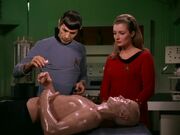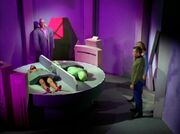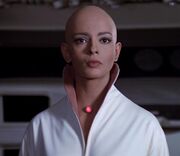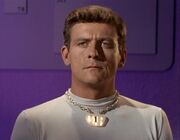m (grammar) |
No edit summary |
||
| Line 3: | Line 3: | ||
Androids began replacing other forms of robots in the late [[22nd century]] when it became clear that a more lifelike appearance was needed for successful interactions with [[Human]]s. The biggest challenge that androids continually had was their inability to fit seamlessly into society. |
Androids began replacing other forms of robots in the late [[22nd century]] when it became clear that a more lifelike appearance was needed for successful interactions with [[Human]]s. The biggest challenge that androids continually had was their inability to fit seamlessly into society. |
||
| + | CSP |
||
| − | |||
Androids were generally used for tasks that humanoids found either dangerous or tedious such as trash collection or cleaning up hazardous materials. Androids were generally many times stronger than the people who built them and therefore are much better able to survive in poor environmental conditions. This ability made them both very useful to their creators but also made them more likely to be destroyed, an issue that [[Federation]] ethicists debated for some time. |
Androids were generally used for tasks that humanoids found either dangerous or tedious such as trash collection or cleaning up hazardous materials. Androids were generally many times stronger than the people who built them and therefore are much better able to survive in poor environmental conditions. This ability made them both very useful to their creators but also made them more likely to be destroyed, an issue that [[Federation]] ethicists debated for some time. |
||
Revision as of 06:33, 12 April 2012

An android being built
An android is an advanced form of robot, equipped with a self-aware artificial intelligence and made with the purpose to imitate humanoid lifeforms in at least a rudimentary physical form.
Androids began replacing other forms of robots in the late 22nd century when it became clear that a more lifelike appearance was needed for successful interactions with Humans. The biggest challenge that androids continually had was their inability to fit seamlessly into society. CSP Androids were generally used for tasks that humanoids found either dangerous or tedious such as trash collection or cleaning up hazardous materials. Androids were generally many times stronger than the people who built them and therefore are much better able to survive in poor environmental conditions. This ability made them both very useful to their creators but also made them more likely to be destroyed, an issue that Federation ethicists debated for some time.
The first truly successful android in the Federation was the Soong-type android Lieutenant commander Data of the USS Enterprise-D. His eventual growth beyond his original programming created renewed interest in the field of humanoid robotics.
Types of androids
Automated Personnel Units
Automated Personnel Unit 3947
In 2372, the USS Voyager found a deactivated android which, upon repair by B'Elanna Torres, identified itself as Automated Personnel Unit 3947. It used Torres' goodwill to gain sympathy for his "people", who were on the verge of extinction after the death of their creators, the Pralor. It was later found that a people known as the Cravic had also made Automated Personnel Units, and that the Cravic were also extinct. Originally, the two peoples had been at war, using the Automated Units to battle. However, when the war ended and it was time to dismantle the APUs, the robots, not understanding anything except war and self-preservation, wiped out their creators and resumed their war. (VOY: "Prototype")
Exo III androids

Android duplicator
A sapient species on the planet Exo III, now known only as "the Old Ones", discovered how to build sophisticated androids thousands of years ago. They made their machines more and more complex, eventually conferring upon them the ability to feel emotions. Their greatest technical achievement was perhaps the android duplicator, a mechanism that could manufacture an exact android duplicate of a living being, including that person's memories.
The Old Ones built their machines too well; according to a surviving machine, Ruk, the Old Ones became afraid of their machines and began to deactivate them. Their survival threatened, the machines overcame their programming and slew their builders. Ruk and all other known Exo III-type androids were destroyed in 2266. (TOS: "What Are Little Girls Made Of?")
Flint-type android
- See: Rayna Kapec
Ilia probe

Ilia probe
The Ilia probe was an android created by V'Ger to gather information about the carbon units aboard the USS Enterprise. It was a highly complex construct built out of the body of the Deltan, Lieutenant Ilia. As a side effect of being made out of a living humanoid, it retained many aspect's of Ilia's personality, including pheromones, memories, and ultimately her emotions. It contained molecule-sized microprocessors and billions of connected mechanisms. (Star Trek: The Motion Picture)
Mudd's androids

Norman, coordinator of the androids of Mudd
In 2268, infamous criminal Harcourt Fenton "Harry" Mudd, having escaped from imminent execution on Deneb V on charges of fraud, fled known space and encountered a Class K planet inhabited by thousands of advanced androids originally from the Andromeda Galaxy. Their makers had established outposts throughout their own galaxy, and had built only a handful of outposts in the Milky Way Galaxy; however, when the sun of their home star system went nova, most of their civilization was destroyed. The remaining makers died out over time, leaving only distant outposts of androids. These androids had their first encounter with native life in the Milky Way when Mudd crash-landed on their planet. Mudd was hardly an ideal model of Humanity, and the androids decided that Humans were a form of galactic pest that needed to be contained for their own protection (and the protection of the galaxy). These androids could have an operational lifespan of up to 500,000 years, and had access to advanced medical technology which could let them transplant humanoid brains into android bodies to grant them virtual immortality.
Mudd was detained, albeit in very comfortable surroundings, as the androids were quite happy to build replicas of any person he wanted, and provide him with any wish he could want (except freedom). When the androids attempted to abduct the USS Enterprise, the crew was able to escape by discovering the weakness of these androids; their minds were so highly logical that by intentionally acting as illogically and unpredictably as possible, the confused androids would be overloaded and incapacitated. (TOS: "I, Mudd")
Sargon-type androids

Henoch and Thalassa, in the bodies of Spock and Ann Mulhall, work on an android
Sargon-type androids were humanoid androids which were created to hold the minds of Sargon, his wife Thalassa, and their friend Henoch, who were the lone survivors of their race.
They had placed their minds in spheres, becoming beings of pure energy. The android bodies would have given them mobility and allow them to leave their planet. They borrowed Human bodies to build the androids.
The plan failed when Henoch, enamoured with the return of physical sensation, tried to destroy Sargon and keep possession of his host, Spock. Although Henoch's plan was foiled, Sargon and Thalassa ultimately did not use the android bodies, as they decided they did not have the discipline to use their mental powers in the physical realm. (TOS: "Return to Tomorrow")
